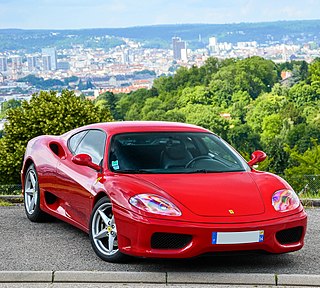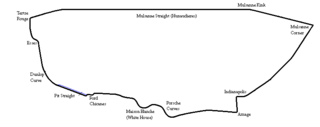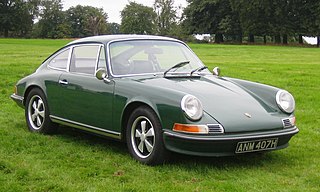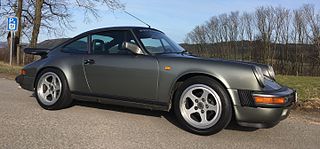
The Porsche 924 is a sports car produced by Porsche in Neckarsulm, Germany, from 1976 until 1988. A two-door, 2+2 coupé, the 924 replaced the 912E and 914 as the company's entry-level model.

The Porsche 930 is the internal designation for the turbocharged variant of the 911 model manufactured by German automobile manufacturer Porsche between 1975 and 1989. It was the maker's top-of-the-range 911 model for its entire production duration and, at the time of its introduction, was the fastest production car available in Germany.

The Ferrari 360 is a two-seater, mid-engine, rear wheel drive sports car manufactured by Italian automotive manufacturer Ferrari from 1999 until 2005. It succeeded the Ferrari F355 and was replaced by the Ferrari F430 in 2004.

The Porsche 993 is the internal designation for the Porsche 911 model manufactured and sold between January 1994 and early 1998, replacing the 964. Its discontinuation marked the end of air-cooled 911 models.

The Porsche 997 is the internal designation for the Porsche 911 sports car manufactured and sold by the German automobile manufacturer Porsche between 2004 and 2013. Production of the Carrera and Carrera S coupés began in early 2004, all-wheel drive Carrera 4 and Carrera 4S began to be delivered to customers in November 2005, the Turbo and GT3 derivatives went on sale in late 2006 and the GT2 in 2007. In addition to the coupé and cabriolet versions, Targa versions of the Carrera 4 and Carrera 4S were also available, which carry on with the "glass canopy" roof design used since its first application on the 993 until the 991, which reverted to the classic targa top layout used on the early 911 Targas.

The Porsche 964 is the company's internal name for the Porsche 911 manufactured and sold between 1989 and 1994. Designed by Benjamin Dimson through January 1986, it featured significant styling revisions over previous 911 models, most prominently the more integrated bumpers. It was the first car to be offered with Porsche's Tiptronic automatic transmission and all wheel drive as options.

The Porsche 935 was a race car developed and manufactured by German automaker Porsche. Introduced in 1976 as the factory racing version of the 911 (930) Turbo and prepared for FIA-Group 5 rules, it was an evolution of the Carrera RSR 2.1 turbo prototype, the second place overall finisher in the 1974 24 Hours of Le Mans.

The Porsche 911 GT3 is a high-performance homologation model of the Porsche 911 sports car. It is a line of high-performance models, which began with the 1973 911 Carrera RS. The GT3 has had a successful racing career in the one-make national and regional Porsche Carrera Cup and GT3 Cup Challenge series, as well as the international Porsche Supercup supporting the FIA Formula 1 World Championship.

The Ruf CTR also known as the CTR Yellowbird or simply Yellowbird, is a limited-production, high performance sports car manufactured by German automobile manufacturer Ruf Automobile. Introduced for the 1987 model year and based on the Porsche 911, the CTR featured an enlarged and highly tuned version of Porsche's 3.2 litre flat-six cylinder engine, lightened body panels, an integrated roll cage, upgraded suspension and braking systems, a custom-designed transmission, and several unique trim pieces such as polyurethane bumpers, and the use of the side-mounted oil filler necessitated by relocating the oil tank forward to clear the intercooler on that side.

The Porsche 908 was a racing car from Porsche, introduced in 1968 to continue the Porsche 906-Porsche 910-Porsche 907 series of models designed by Helmuth Bott (chassis) and Hans Mezger (engine) under the leadership of racing chief Ferdinand Piëch.

The 1982 24 Hours of Le Mans was the 50th Grand Prix of Endurance, which took place on 19 and 20 June 1982. It was also the fourth round of the 1982 World Endurance Championship. As well as a significant anniversary, this was a watershed year for Le Mans, with the highly anticipated advent of the FIA's Group C regulations, the essence of which was to allow an open engine formula but a minimum weight for safety and a proscribed fuel allocation.

The 1977 24 Hours of Le Mans was the 45th Grand Prix of Endurance, and took place on 11 and 12 June 1977. The second year of the FIA Group 5 and Group 6 regulations, it produced an exciting race right up to the end. Porsche had withdrawn from the Group 6 Championship, citing a lack of broad competition. Renault, before their move into Formula 1, decided to put its main racing focus for the year onto Le Mans. The two works teams were the pre-race favourites.

The 1976 24 Hours of Le Mans was the 44th Grand Prix of Endurance, and took place on 12 and 13 June 1976. This year the FIA introduced its new Group 5 and Group 6 regulations and the race was now open to nine distinct classes, although it was still not part of the World Championship seasons. Porsche introduced its new models, the 936 in Group 6, the 935 in Group 5 and the 934 in Group 4. In response, BMW had its modified 3.0 CSL in Group 5. It was the year that turbos arrived in considerable numbers, with over a dozen turbocharged entries, led by the Renault Alpine A442. It saw the arrival of French prototype manufacturers Jean Rondeau and Gérard Welter in a new GTP class and a first-time invitation to American IMSA and NASCAR entries.

The Porsche 911 GT2 is a high-performance, track-focused sports car built by the German automobile manufacturer Porsche from 1993 to 2009, and then since 2010 as the GT2 RS. It is based on the 911 Turbo, and uses a similar twin-turbocharged engine, but features numerous upgrades, including engine enhancements, larger brakes, and stiffer suspension calibration. The GT2 is significantly lighter than the Turbo due to its use of rear-wheel-drive instead of all-wheel-drive system and the reduction or removal of interior components. As a result, the GT2 is the most expensive and fastest model among the 911 lineup.
Group 5 was an FIA motor racing classification which was applied to four distinct categories during the years 1966 to 1982. Initially Group 5 regulations defined a Special Touring Car category and from 1970 to 1971 the classification was applied to limited production Sports Cars restricted to 5 litre engine capacity. The Group 5 Sports Car category was redefined in 1972 to exclude the minimum production requirement and limit engine capacity to 3 litres. From 1976 to 1982 Group 5 was for Special Production Cars, a liberal silhouette formula based on homologated production vehicles.

The original Porsche 911 is a luxury sports car made by Porsche AG of Stuttgart, Germany. A prototype of the famous, distinctive, and durable design was shown to the public in autumn 1963. Production began in September 1964 and continued through 1989. It was succeeded by a modified version, internally referred to as Porsche 964 but still sold as Porsche 911, as are current models.

The Porsche 991 is the internal designation for the seventh generation of the Porsche 911 sports car, which was unveiled at the 2011 Frankfurt Motor Show on 15 September as the replacement for the 997. The 991 was an entirely new platform, only the third since the original 911 launched in 1963. Production of the 991 generation ended on December 20, 2019, with 233,540 units produced.

The Porsche 981 is the internal designation given to the third-generation of the Boxster and second generation of the Cayman models built by German automobile manufacturer Porsche. It was announced on 13 March 2012 at the Geneva Auto Show with sales starting early summer 2012.

The Porsche 911 is a two-door 2+2 high performance rear-engined sports car introduced in September 1964 by Porsche AG of Stuttgart, Germany. It has a rear-mounted flat-six engine and originally a torsion bar suspension. The car has been continuously enhanced through the years but the basic concept has remained unchanged. The engines were air-cooled until the introduction of the 996 series in 1998.

The Ruf SCR is a sports car manufactured by German automobile manufacturer Ruf Automobile. The SCR was based on the Porsche 911 SC and the changes made to its engine enabled it to have similar performance to the 930 Turbo, despite having a naturally aspirated engine.




















